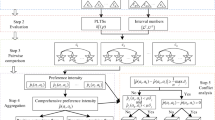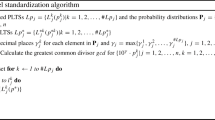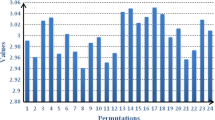Abstract
The probabilistic linguistic term set (PLTS) is a powerful tool for describing linguistic evaluations derived from expert teams and has adequate capability to identify preferences among different evaluations. Due to the practicability of PLTSs, probabilistic linguistic decision making problems have been widely investigated in recent years. However, no study on probabilistic linguistic outranking relations has been conducted. This study aims to explore effective processing for the complex two-dimension structure of PLTSs and formulate probabilistic linguistic dominance and opposition relations for multi-criteria sorting decision making. Linguistic scale functions, which can generate different semantics for linguistic variables under different decision making environments, are introduced to deal with the linguistic terms in PLTSs. In this way, the probabilistic linguistic dominance degree, concordance and discordance indices are defined by systematically comparing the probabilities of PLTSs. Then, two kinds of outranking relations with dominance and opposition for PLTSs are formulated based on the defined outranking indices. Subsequently, an innovative sorting decision making framework is constructed by exploring the outranking relations between alternatives and characteristic actions under multiple criteria and implementing the outranking aggregation and exploitation. Finally, this framework is demonstrated using an illustrative example with result analyses and comparison discussions.






Similar content being viewed by others
References
Almeida-Dias, J., Figueira, J. R., & Roy, B. (2010). ELECTRE TRI-C: A multiple criteria sorting method based on characteristic reference actions. European Journal of Operational Research, 204(3), 565–580.
Feng, X., Liu, Q., & Wei, C. (2019). Probabilistic linguistic QUALIFLEX approach with possibility degree comparison. Journal of Intelligent & Fuzzy Systems, 36, 719–730.
Fernandez, E., & Navarro, J. (2011). A new approach to multi-criteria sorting based on fuzzy outranking relations: The THESEUS method. European Journal of Operational Research, 213(2), 405–413.
Gao, J., Xu, Z. S., Liang, Z., & Liao, H. C. (2019). Expected consistency-based emergency decision making with incomplete probabilistic linguistic preference relations. Knowledge-Based Systems, 176, 15–28.
Kadziński, M., Tervonen, T., & Figueira, J. R. (2015). Robust multi-criteria sorting with the outranking preference model and characteristic profiles. Omega, 55, 126–140.
Liao, H. C., Jiang, L., Lev, B., & Fujita, H. (2019). Novel operations of PLTSs based on the disparity degrees of linguistic terms and their use in designing the probabilistic linguistic ELECTRE III method. Applied Soft Computing, 80, 450–464.
Liao, H., Mi, X., & Xu, Z. (2020). A survey of decision-making methods with probabilistic linguistic information: Bibliometrics, preliminaries, methodologies, applications and future directions. Fuzzy Optimization and Decision Making, 19, 81–134.
Liu, Y., Fan, Z. P., & Zhang, Y. (2011). A method for stochastic multiple criteria decision making based on dominance degrees. Information Sciences, 181(19), 4139–4153.
Liu, P., & Li, Y. (2018). The PROMTHEE II method based on probabilistic linguistic information and their application to decision making. Informatica, 29(2), 303–320.
Liu, P., & Teng, F. (2018). Some Muirhead mean operators for probabilistic linguistic term sets and their applications to multiple attribute decision-making. Applied Soft Computing, 68, 396–431.
Luo, S. Z., Zhang, H. Y., Wang, J. Q., & Li, L. (2019). Group decision-making approach for evaluating the sustainability of constructed wetlands with probabilistic linguistic preference relations. Journal of the Operational Research Society, 70(12), 2039–2055.
Mao, X. B., Wu, M., Dong, J. Y., Wan, S. P., & Jin, Z. (2019). A new method for probabilistic linguistic multi-attribute group decision making: Application to the selection of financial technologies. Applied Soft Computing, 77, 155–175.
Mi, X., Liao, H., Wu, X., & Xu, Z. (2020). Probabilistic linguistic information fusion: A survey on aggregation operators in terms of principles, definitions, classifications, applications, and challenges. International Journal of Intelligent Systems, 35(3), 529–556.
Pang, Q., Wang, H., & Xu, Z. S. (2016). Probabilistic linguistic term sets in multi-attribute group decision making. Information Sciences, 369, 128–143.
Peng, H. G., & Wang, J. Q. (2018). A multicriteria group decision-making method based on the normal cloud model with Zadeh’s Z-numbers. IEEE Transactions on Fuzzy Systems, 26(6), 3246–3260.
Peng, J. J., Wang, J. Q., Wang, J., Yang, L. J., & Chen, X. H. (2015). An extension of ELECTRE to multi-criteria decision-making problems with multi-hesitant fuzzy sets. Information Sciences, 307, 113–126.
Peng, H. G., Wang, J. Q., & Zhang, H. Y. (2020). Multi-criteria outranking method based on probability distribution with probabilistic linguistic information. Computers & Industrial Engineering, 141, 106318.
Rodriguez, R. M., Martinez, L., & Herrera, F. (2012). Hesitant fuzzy linguistic term sets for decision making. IEEE Transactions on Fuzzy Systems, 20(1), 109–119.
Roy, B. (1991). The outranking approach and the foundations of ELECTRE methods. Theory and Decision, 31, 49–73.
Shen, F., Xu, J., & Xu, Z. S. (2016). An outranking sorting method for multi-criteria group decision making using intuitionistic fuzzy sets. Information Sciences, 334, 338–353.
Tang, M., Long, Y., Liao, H., & Xu, Z. (2019). Inclusion measures of probabilistic linguistic term sets and their application in classifying cities in the Economic Zone of Chengdu Plain. Applied Soft Computing, 82, 105572.
Wang, J. C., & Chen, T. Y. (2015). Likelihood-based assignment methods for multiple criteria decision analysis based on interval-valued intuitionistic fuzzy sets. Fuzzy Optimization and Decision Making, 14(4), 425–457.
Wu, X., & Liao, H. C. (2019). A consensus-based probabilistic linguistic gained and lost dominance score method. European Journal of Operational Research, 272(3), 1017–1027.
Zadeh, L. A. (1975). The concept of a linguistic variable and its application to approximate reasoning-I. Information Sciences, 8(3), 199–249.
Zhang, Y., Xu, Z. S., Wang, H., & Liao, H. C. (2016). Consistency-based risk assessment with probabilistic linguistic preference relation. Applied Soft Computing, 49, 817–833.
Acknowledgements
The authors are very grateful to the anonymous reviewers for their valuable comments and suggestions to help improve the overall quality of this paper. This work was supported by the National Natural Science Foundation of China (No. 71871228).
Author information
Authors and Affiliations
Corresponding author
Additional information
Publisher's Note
Springer Nature remains neutral with regard to jurisdictional claims in published maps and institutional affiliations.
Appendix
Appendix
Proof of Property 2
(1) Necessity If \( X_{1} (p) >_{sd} X_{2} (p) \), then \( C(X_{1} (p),X_{2} (p)) - C(X_{2} (p),X_{1} (p)) = 1 \) can be obtained from Definition 7. In this case, we have \( C(X_{1} (p),X_{2} (p)) = 1 \) and \( C(X_{2} (p),X_{1} (p)) = 0 \) in light of Property 1. Then, according to Definition 6, the following inequalities can be deduced:
for all \( x_{1} \in X_{1} (p) \) and \( x_{2} \in X_{2} (p) \).
Therefore, based on the intersection operation, \( x_{1} > x_{2} \) and \( p_{1} - p_{2} \ge - q_{j} \), and \( x_{1} = x_{2} \) and \( p_{1} - p_{2} \ge r_{j} \) are true for all \( x_{1} \in X_{1} (p) \) and \( x_{2} \in X_{2} (p) \).
(2) Sufficiency Since \( x_{1} > x_{2} \) and \( p_{1} - p_{2} \ge - q_{j} \), and \( x_{1} = x_{2} \) and \( p_{1} - p_{2} \ge r_{j} \) are valid for all \( x_{1} \in X_{1} (p) \) and \( x_{2} \in X_{2} (p) \), according to Definition 6, the following equalities can be deduced:
Then, \( C(X_{1} (p),X_{2} (p)) - C(X_{2} (p),X_{1} (p)) = 1 \) can be obtained. Therefore, \( X_{1} (p) >_{sd} X_{2} (p) \) is verified.□
Proof of Property 3
-
(1.1)
Since \( C(X_{1} (p),X_{1} (p)) - C(X_{1} (p),X_{1} (p)) = 0 \ne 1 \), \( X_{1} (p)\not >_{sd} X_{1} (p) \).
-
(1.2)
When \( X_{1} (p) >_{sd} X_{2} (p) \), \( C(X_{1} (p),X_{2} (p)) = 1 \) and \( C(X_{2} (p),X_{1} (p)) = 0 \) can be obtained according to Definition 7 and Property 1. Then, \( C(X_{2} (p),X_{1} (p)) - C(X_{1} (p),X_{2} (p)) = - 1 \ne 1 \) can be deduced. Therefore, \( X_{1} (p) >_{sd} X_{2} (p) \)\( \not \Rightarrow X_{2} (p) >_{sd} X_{1} (p) \).
-
(1.3)
When \( X_{1} (p) >_{sd} X_{2} (p) \) and \( X_{2} (p) >_{sd} X_{3} (p) \), \( x_{1} > x_{2} \) and \( p_{1} - p_{2} \ge - q_{j} \), \( x_{2} > x_{3} \) and \( p_{2} - p_{3} \ge - q_{j} \), \( x_{1} = x_{2} \) and \( p_{1} - p_{2} \ge r_{j} \), and \( x_{2} = x_{3} \) and \( p_{2} - p_{3} \ge r_{j} \) for all \( x_{1} \in X_{1} (p) \), \( x_{2} \in X_{2} (p) \) and \( x_{3} \in X_{3} (p) \) can be obtained according to Property 2. Then, \( x_{1} > x_{3} \) and \( p_{1} - p_{3} \ge - 2q_{j} \) can be deduced. However, \( p_{1} - p_{3} \ge - 2q_{j} \)\( \not \Rightarrow p_{1} - p_{3} \ge - q_{j} \). Therefore, \( X_{1} (p) >_{sd} X_{2} (p) \) and \( X_{2} (p) >_{sd} X_{3} (p) \)\( \not \Rightarrow X_{1} (p) >_{sd} X_{3} (p) \).
Similar to (1.1) and (1.2), (2.1), (2.2), (3.1), (3.2), (4.1) and (4.2) can be proved easily.□
Property 2 presents the conditions of the strong dominance relation. However, the conditions of the moderate, weak and indifferent dominance relations cannot be obtained because \( C(X_{1} (p),X_{2} (p)) \) and \( C(X_{2} (p),X_{1} (p)) \) in cases (2), (3) and (4) in Definition 7 cannot be determined explicitly. In this case, it is difficult to prove the non-transitivity of the moderate, weak and indifferent dominance relations. Motivated by the idea in Peng et al. (2015), where the non-transitivity of outranking relations is exemplified, several examples are provided to demonstrate the non-transitivity of the moderate, weak and indifferent dominance relations in the following.
Example 6
Let \( q_{j} = 0.05 \) and \( r_{j} = 0.15 \), then the non-transitivity can be exemplified as follows:
-
(1)
Let \( X_{1} (p) = \{ s_{3} (0.3),s_{4} (0.3),s_{5} (0.2)\} \), \( X_{2} (p) = \{ s_{2} (0.1),s_{3} (0.3),s_{4} (0.3),s_{5} (0.1)\} \), and \( X_{3} (p) = \{ s_{5} (0.3),s_{6} (0.3),s_{7} (0.3)\} \) be three PLTSs, then \( C(X_{1} (p),X_{2} (p)) - C(X_{2} (p),X_{1} (p)) = 0.3 \), \( C(X_{3} (p),X_{1} (p)) - C(X_{1} (p),X_{3} (p)) = 0.9407 \), and \( C(X_{3} (p),X_{2} (p)) - C(X_{2} (p),X_{3} (p)) = 1 \). Therefore, \( X_{3} (p) >_{md} X_{1} (p) \), \( X_{1} (p) >_{md} X_{2} (p) \), but \( X_{4} (p) >_{sd} X_{2} (p) \). This indicates that the non-transitivity of the moderate dominance relation is true.
-
(2)
Let \( X_{1} (p) = \{ s_{2} (0.2),s_{3} (0.2),s_{4} (0.2),s_{5} (0.2)\} \), \( X_{2} (p) = \{ s_{2} (0.3),s_{3} (0.1),s_{4} (0.3),s_{5} (0.2)\} \), and \( X_{3} (p) = \{ s_{2} (0.4),s_{3} (0.3),s_{4} (0.2)\} \) be three PLTSs, then \( C(X_{2} (p),X_{1} (p)) - C(X_{1} (p),X_{2} (p)) = 0.1250 \), \( C(X_{1} (p),X_{3} (p)) - C(X_{3} (p),X_{1} (p)) = 0.0833 \), and \( C(X_{2} (p),X_{3} (p)) - C(X_{3} (p),X_{2} (p)) = 0.2333 \). Therefore, \( X_{2} (p) >_{wd} X_{1} (p) \), \( X_{1} (p) >_{wd} X_{3} (p) \), but \( X_{2} (p) >_{md} X_{3} (p) \). This indicates that the non-transitivity of the weak dominance relation is true.
-
(3)
Let \( X_{1} (p) = \{ s_{2} (0.1),s_{3} (0.3),s_{4} (0.4),s_{5} (0.2)\} \), \( X_{2} (p) = \{ s_{2} (0.2),s_{3} (0.3),s_{4} (0.2),s_{5} (0.3)\} \), and \( X_{3} (p) = \{ s_{2} (0.1),s_{3} (0.4),s_{4} (0.3),s_{5} (0.2)\} \) be three PLTSs, then \( C(X_{1} (p),X_{2} (p)) - C(X_{2} (p),X_{1} (p)){ = }0. 055 \), \( C(X_{1} (p),X_{3} (p)) - C(X_{3} (p),X_{1} (p)){ = }0.045 \), and \( C(X_{3} (p),X_{2} (p)){ - }C(X_{2} (p),X_{3} (p)){ = 0} . 0 4 \). Therefore, \( X_{1} (p) \sim_{id} X_{3} (p) \), \( X_{3} (p) \sim_{id} X_{2} (p) \), but \( X_{1} (p) >_{wd} X_{2} (p) \). This indicates that the non-transitivity of the indifferent dominance relation is true.
Rights and permissions
About this article
Cite this article
Peng, Hg., Wang, Jq. Multi-criteria sorting decision making based on dominance and opposition relations with probabilistic linguistic information. Fuzzy Optim Decis Making 19, 435–470 (2020). https://doi.org/10.1007/s10700-020-09330-z
Published:
Issue Date:
DOI: https://doi.org/10.1007/s10700-020-09330-z




